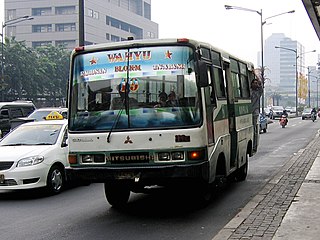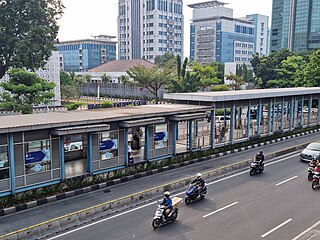List of routes
The following is the set of routes currently in service. The bus numbers and routes sometime show prefix letters which indicate the following:
- P = Central Jakarta (Jakarta Pusat)
- B = West Jakarta (Jakarta Barat)
- S = South Jakarta (Jakarta Selatan)
- T = East Jakarta (Jakarta Timur)
- U = North Jakarta (Jakarta Utara)
From Pasar Senen
001 Senen - RS Islam Cempaka Putih - Taman Solo
003 Senen - Cempaka Putih - Rawamangun
005 Senen - Johar Baru - Mardani
007 Senen - Cempaka Mas - Semper
010 Senen - Kemayoran - Sunter
011 Senen - Kemayoran - Bendungan Jago
015 Senen - Sabang - Setiabudi
017 Senen - Cikini - Manggarai
047 Senen - Cempaka Putih - Pondok Kopi
From Tanjung Priok
023 Tanjung Priok - Cilincing
024 Tanjung Priok - Sunter - Senen (Now became Transjakarta route 10K)
From Kota
029 Kota - Pademangan - Sunter
030 Kota - Pluit - Muara Angke
From Pulo Gadung
041 Pulo Gadung - Tugu - Tanjung Priok
042 Pulo Gadung - Penggilingan - Perumnas Klender
043 Pulo Gadung - Pondok Ungu - Seroja
044 Pulo Gadung - Penggilingan - Pulo Gebang (Now became Transjakarta route 11D)
045 Pulo Gadung - Jatiwaringin - Pondok Gede (Now became Transjakarta route 4F (extended until Pinang Ranti)
046 Pulo Gadung - Utan Kayu - Kampung Melayu
049 Pulo Gadung - Rawamangun Muka - Utan Kayu - Pramuka - Tambak - Manggarai
From Kampung Melayu
050 Kampung Melayu - Duren Sawit - Perumnas Klender
052 Kampung Melayu - Buaran - Stasiun Cakung (Now became Transjakarta route 11Q)
053 Kampung Melayu - Otista - Dewi Sartika - Condet - Kampung Rambutan
054 Kampung Melayu - Kalimalang - Pondok Kelapa (Now became Transjakarta route 7P (Starting from BKN Cililitan))
506 Kampung Melayu - Klender - Pondok Kopi
783 Kampung Melayu - Kalimalang - Cibubur - Cileungsi
From Manggarai
060 Manggarai - Tebet - Kampung Melayu
061 Manggarai - Bukit Duri - Kampung Melayu
062 Manggarai - Pancoran - Pasar Minggu (Now became Transjakarta route 4B (extended until University of Indonesia))
From Blok M
069 Blok M - Kyai Maja - Kreo - Ciledug
070 Blok M - Pos Pengumben - Joglo (Now became Transjakarta route 8D)
071 Blok M - Tanah Kusir - Kodam Bintaro (Now became Transjakarta route 8E)
072 Blok M - Pasar Mayestik - Radio Dalam - Pondok Indah – Lebak Bulus
074 Blok M - Tanah Kusir - Rempoa (Now became Transjakarta route 1Q)
075 Blok M - Tendean - Warung Buncit - Mampang - Pejaten Barat - Pasar Minggu (Now became Transjakarta route 6U)
076 Blok M - Cilandak - Tol TB. Simatupang - Kampung Rambutan
077 Blok M - Bangka - Mampang - Ragunan Depan
078 Blok M - Mayestik - Kebayoran Lama - Cidodol
079 Blok M - Fatmawati - Lebak Bulus
610 Blok M - Cipete - RS Fatmawati - Pondok Labu (Now became Transjakarta route 1E)
611 Blok M - Pondok Pinang - Pasar Jumat - Lebak Bulus
619 Blok M - Pangeran Antasari - TB Simatupang - RS Fatmawati - Pondok Labu - Cinere
733 Blok M- Bintara - Kranji
811 Blok M - Lebak Bulus - Rempoa - Bintaro
From Kalideres
082 Kalideres - Kamal - Kapuk - Grogol
084 Kalideres - Pluit - Kota
085 Kalideres - Permata Hijau - Lebak Bulus
Other routes
058 Cililitan - Pondok Bambu - Perumnas Klender
064 Pasar Minggu - Kalibata - Cililitan
091 Batusari - Tanjung Duren - Citraland - Grogol - Roxy Mas - Tanah Abang (Now became Transjakarta route 8K)
092 Joglo - Kedoya - Jalan Panjang - Daan Mogot - Grogol
640 Pasar Minggu - Pancoran - Gatot Subroto - Thamrin - Tosari - Tanah Abang (Now became Transjakarta route 9D)
719 Lebak Bulus - Pondok Gede - Jatiasih
789 Perumnas Klender - Pulo Gadung - Harapan Indah
792 Perumnas Klender - Pondok Kelapa - Bekasi


















